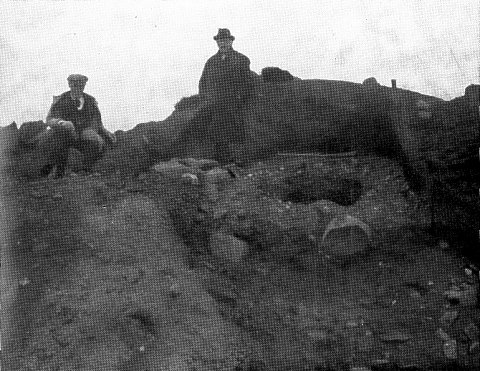
Knoc y Doonee
West face, showing walling and the face of the layer of small stones with broken pieces of white quartz
[From Proc IoMNH&ASoc vol 3]
P. M. C. KERMODE, F.S.A. SCOT. 15 December, 1927.
A low range of sandhills crosses the north of the parish of Andreas, rising from 100 ft. above the mouth of the Lhen on the West to 182 ft, at Knoc y doonee, its greatest elevation. Upon this height, just a mile due South of Rue Point, stands the fine cronk or tumulus which Mr, Martin. allowed us to examine in the Autumn of this year.

Knoc y Doonee
West face, showing walling and the face of the layer of small stones with broken
pieces of white quartz
The diameter of the mound was 51 ft.; the height appeared to be about 7 to 8ft. above the level of the field, but it was found that more than a foot of this was due to the paring of the hill-top for some yards around, whence evidently had been brought the heavy red sand of which the mound was composed, and the plough had helped to reduce the level around the base, The northern face had been weathered and worn by sheep to a point 4 ft. within the original circumference, and the exposed section revealed a layer, 6 to 8 in, thick, of small boulders representing a covering over the sand, upon which another mass of sand had been heaped to finish the monu ment and form the tumulus. The section of a cutting made from the northern face to the centre of the mound, disclosed the line of this covering rising gradually to a point about 4 ft. north of the centre, then sinking over what turned out to have been the Burial.
On the western face, at a point about 7 ft. in from the circumference and at a level of about 2 ft. above the surface of the field, some large boulders had been exposed, marking the position of a retaining wall, 18 in. high and 2 ft. wide, which however I was not able to trace all round the mound. It was from the top of this wall that the covering layer of small tightly-wedged boulders began, which formed a compact vaulted roof over the contents and protected the remains from further pressure.
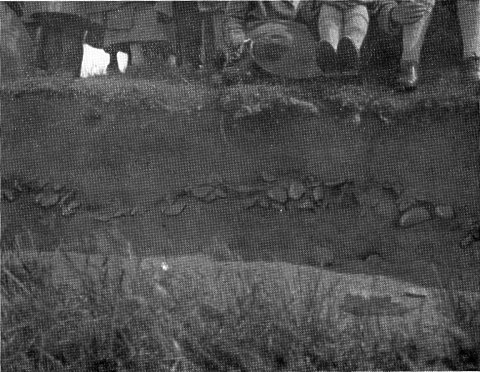
Knoc y Doonee
North face of mound, showing exposed section of of layer of small stones
About 3 ft. north of the centre we came to a thin brown layer in the sand at a depth from the top of 6 ft. 6 in. On this, f noticed first a heavy, iron axe-head of unusual shape, 7½ in. by 5 in. across the cutting edge, and within it a fragment, greatly decayed, of the wooden handle,1¼ in. diameter. Close by were the broken pieces of a sword. What remained measured 32 in., and the decayed wood of the sheath, originally no doubt covered with hide, was still adhering to it. A few inches from the sword was the cup-shaped boss of a shield, 7 in, diam, by 3¼ in. deep, while, close by, lay the socketed head of a spear, 12½ in. with about 4 in of the socket having the decayed remains of its wooden shaft. A small buckle (plain) and some fragments, with a cloak-pin, of bronze which had borne enamel, and little bits of leather straps, showed that the warrior had been belted and wrapped in his cloak. About the middle space was an iron bowl, 15 in. diam. by 5 in. deep, ornamented by small bosses, once covered with canvas but now entirely filled with sand; near by was a Norwegian knife (not a clasp-knife) with bone handle 7¼ in. At the S.W. end, a hammer and pair of smith's tongs of a form and size used at the present day. One more article was found close to these, namely a fishing weight of lead, pierced at the top for suspension on a line from the boat, and below to allow of a snood with baited hook to be trailed along the sea-bottom ; with this was another knife 5 in. long. All these things were on a level and lay in a direction from N.E. to S.W. Along with them I noticed a good many boulders without any definite arrangement, which, perhaps, had been placed under the boat to support it while the sand was being shovelled in. At the S.W. end, several of these boulders were piled in a little heap, about 15 in. high. I removed them one by one but found nothing in or under the pile. It may have marked the position of the stern. My reason for suggesting a. Boat Burial, which is a type not hitherto found in the Isle of Man, is that, scattered all along the brown layer, we found iron bolts, many with remains of wood attached, of a size suitable for a small boat,-I have counted over 260,-and there is no other way by which their appearance and distribution can be explained. They had apparently dropped out as the wood decayed, and (not expecting any thing of the kind) I did not notice their precise positions, though I did take note of the furthest points N.E. and S. W. of the centre where they were met with. These would allow for a boat about 30 ft. long, 6 ft. wide and 3 ft. high.
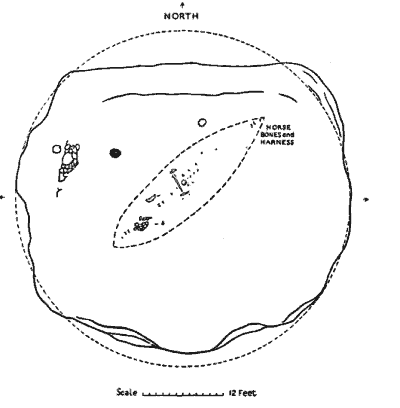
The only trace of human bone was the fragment of a skull; otherwise it had been entirely absorbed by the limeless soil, leaving only flakes of compact, black, exceedingly fine and soft powder which must represent decayed animal matter as distinct from the paler traces of decayed wood and fibre.
But at the N.E. end, in a position which seems to have been just outside the prow, some greatly-decayed it agments of large bone were met with, including the lower jaw, with teeth, of a horse, with also bits of harness. On this same level, at a point 12 ft. N.W. of the centre was a patch, about 15 in. diam., of flakes, of dark, soft matter, with a few small boulders intentionally arranged. This may well have been his dog laid here -a faithful friend - to be a companion to his master into the unknown.
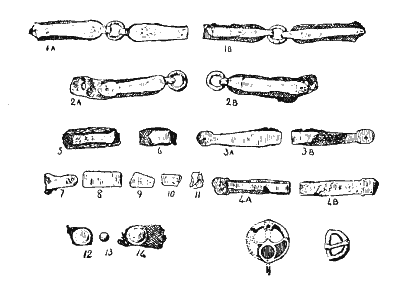
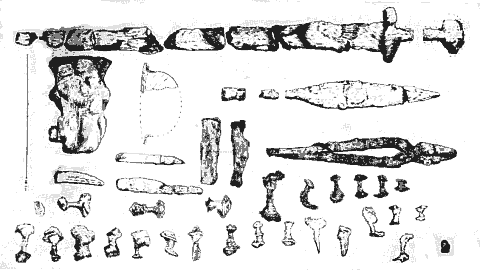
Articles from the Knoc y Doonee Mound
The Norseman buried here must have been the owner of the land round about, and holdings in those days of small population and very small cultivation, were much larger than in our times. We may suppose him to have had not only the Treen, recorded in 1515 as Balynessar, but those of Smeale mooar and beg on the E. and S., and of Leodest on the S. This would allow of a good sheep-run, with grazing also for cattle and horses and a sufficiency of corn land; it was well-watered, and the owner would find plenty of wild fowl and plenty of fish to keep his larder well supplied. With its southern aspect it must have made a choice holding. Precisely where the house and homestead were set we have no indication. When he 'fared to Odin' (as the Norseman would express it), the owner was placed in his own small boat, which would have been brought up from the beach, opposite what is row the Ballakinnag road, and furnished for a voyage. His sword and spear, his shield and great axe were set ready to his hand ; his fishing gear and leaden weight were put in, and, because of his renown as a Smith-a most important and honoured craft in those days,-his hammer and tongs were added. Then his horse was harnessed to the boat and, having drawn it to the top of the hill, was sacrificed as an acceptable offering to the Father of the gods, its blood being collected in the iron bowl, covered over with canvas and placed within the boat; his faithful dog was honoured by being laid in the same mound. One of the knives was lying by the bowl and may well have been the sacrificial knife, the other with the fishing gear may have been used on the dog. Some of the leather found in the boat might be from the shoes-the last thing to be attached before burial. The boat having been drawn to the spot, was tented over or covered with planks and supported by the boulders we have seen; a low retaining wall was then raised and the sand excavated from around, lightly spread to the height of the wall, rising in the centre over the grave.
The surface and appearance of this whole range of sandhills was very different then from now. They had never known a plough or been under cultivation, and the light sand bore but a scanty covering of bent and self-sown grasses. The loose soil was therefore easy to excavate; men, women and children would set to work to make baskets and creels of the bent at their hands, fill them even with their fingers and empty them on the rising mound which would grow more quickly than we perhaps imagine.
Small boulders were closely and firmly packed over the sand so as to form a vaulted roof and protect the remains from further pressure ; and then a thing was done which I have neither seen nor heard of before. A number of the boulders of white quartz were broken into small fragments and scattered freely over this vaulting. The time and trouble taken over this, show that it was for a definite purpose. We have been accustomed to find white shore pebbles associated with graves in all periods in the Isle of Man, from our Megalithic monuments to Christian churchyards in the 18th century, but these were never intentionally broken. As they were to be covered over with sand it could not be for their display. Was it suggested by the local tradition unfamiliar to and not well understood by the Norseman ? or, was it merely for the purpose of consolidating the vaulted roof and giving it an even surface ? It seems in any case to be worth noting. After this more sand was spread over all, raising the top by what, after a thousand years of settlement and of weathering, has come to be compressed into another 3 ft., spilling over the retaining wall and reaching to the present base of the cronk.
No trace of any secondary burial was found, and this suggests a date at the very end of our (local) Scandinavian heathendom; his sons we may suppose when their time came, being laid to rest elsewhere and in a Christian cemetery. In this connection it is interesting to remember that on the same sandhills, at a distance westward of only a quarter of a mile there was at that time, and had then been for four centuries, a little Christian place of worship with its surrounding cemetery. In 'the Lord's Books, already referred to, we find the full name of the Treen given as 'Balynessar and Kyrke Asston.' This can only refer to the Keeill where some years ago we found the Bi-lingual Ogam inscription 'Ammecat son of Rocat.' The fact that in our Scandinavian times it came to be called a 'Kirk' shows that it was then still in use, though not necessarily so while Knoc y doonee was still in heathen hands.
Now, you will all remember that at Kirk Michael we have among other Scandinavian Crosses, one handsomely carved by our first Norse sculptor, Gaut, the inscription of which tells us that it was set up by 'Maelbrigde son of Athacan the Smith for the good of his soul.' This is the only example we have of this formula, and one reason for its use may be that Maelbrigde was then a recent convert to Christianity, who humbled and penitent, had been taught that faith was shown by good works. The date of this inscription would be about 950 and I suggest that here at Knoc y doonee, we have found the burial place of his father-'Athacan the Smith,'
The term 'Smith' among the Norse bad a larger significance than it has with us ; the ship-builder is the ship-smith, the Poet the verse-smith, and so on ; still, we may picture Athacan in the words of Longfellow :
'The smith a mighty man is he,
With large and sinewy hands;
And the muscles of his brawy arms
Are strong as iron bands.'
And I feel sure we may add of him, he. . . 'looks the whole world in the face, For he owes not any man.'
15 December, 1927.
While listening to Mr. P.. M. C. Kermode's paper on the Knock y doonee tumulus, one could not help being impressed by the interesting manner in which he clothed his discoveries in a halo of romance. Some would have presented one with a table of empty vases, but all Mr. Kermode's vases were laden with the rarest and choicest blooms. The human and animal remains, the hammer and tongs, emblems of the deceased's craftsmanship ; his sword and spear, and even the nails or bolts which held his funerary boat together; all these were not merely scraps of bone, iron ur wood, as they might appear to the ordinary man, but each of them had its own tale to tell of a simple but, withal, magnificent funeral which took place about one thousand years ago.
To Mr. Kermode, these remains spoke as eloquently as those of Tut Ankh Amen, the Egyptian monarch, and in truth one must confess that the story of Athakan the Smith is equally as interesting as that of the former. Here at Knock y doonee was not the pomp, glory and splendour of regal power, but a simple burial of a craftsman. Placed in his boat with his accoutrements, his sword and spear, and even his fishing-line; his favourite horse and hound beside him to accompany him on his last journey; and covered over with stones and earth raised into a huge cairn as a memorial that all men might know that Athakan the Smith lay here. And surely he must have been held in the highest esteem in his native parish of Kirk Andreas, or else they would not have erected over his remains what must have been regarded in those days as a magnificent mausoleum.
Mr. Kermode's paper opens up a large field of inquiry in regard to the personal and place-names which come within the scope of it. His discoveries and suggestions are of far-reaching importance, and I hope that the following observations will further strengthen his hypotheses.
Mr. Kermode's suggestion that Athakan the Smith, whose memory is preserved on a cross-slab in Kirk Michael churchyard, was the individual buried in this tumulus, is certainly within the bounds of possibility. The translated runic inscription runs thus: ,Mael Brigdi, son of Athakan the Smith, erected this cross for his own soul (and that of) his brother's wife. Gaut made this and all in Man.' Here we have two purely Gaelic names, but it must be remembered that in the loth and i ith centuries Gael and Norseman had fused into one race, known to their pure-blooded Gaelic neighbours as the Gall Gael or Stranger Gael. The spelling of the names, however, proves that they had already been borrowed into the Norse tongue previous to the loth century. The old Irish names were Mael Brigde and Aedagan, and these were the forms borrowed by the Norsemen. After the l0th century a gradual phonetic decay began in the Irish language, which has not yet entirely ceased. The names mentioned became respectively Maol Brighde and Aodhagan, g and d being aspirated and in pronunci ation wholly suppressed. Later Maol Brighde became GallGaelicized into Gild Brighde, and then, as a purer Gaelic idiom began to replace that of the Stranger Gael, this became Mac Gil Brighde, from which our own later Manx surname Mylevreeshey was derived. Also from Mac Aodhagdin comes our modern Manx surname Keggin. Both of these surnames still survive in the Island, the former in its translated English form Bridson. The latter name, however, is also the modern form of Breden, a surname of Norman extraction. In the loth and 11th centuries, surnames had not yet developed, and it is very improbable that Mael Brigde or Athakan passed their names on to posterity.
The Runic inscription informs us that Athakan was a smith, which was probably the most important craft in Man at that time. The Norse smibr had a wide interpretation, meaning a smith or blacksmith, a carpenter or wright, a craftsman in metal or wood, or a ship or house-builder. The Gaelic saor was almost identical in meaning, whilst gabba was usually confined to the trade of a blacksmith or worker in iron. From these Gaelic trade-names the surnames Mac an tSaoir, 'son of the craftsman,' and Mac an Ghab hann, 'son of the blacksmith,' were evolved. These became Mac Teare and Mac Gawne in Man, and later Teare and Gawne respectively. Did these surnames develop independently in Manor were they imported from Ireland? With the available evidence we have I think we may safely assume that the former was the case.
The treen on which Athakan's mausoleum was erected was part of his patrimony, and probably belonged to his ancestors for generations, and, as a matter of fact, this is amply proved by the name of his homestead, Balley ny seyr (Ir. Baile na saor), 'the homestead of the craftsmen.' The use of the genitive plural instead of the singular is sufficient evidence to prove that Athakan was not the first smith who held the treen, but that his ancestors had followed the same craft on the same homestead. Important trades of this description descended from father to son through many generations.
The adjoining treen of Smeale suggests a worn down form of Smibaból, I smiths' homestead.' Ból means reclaimed and cultivated land, a farm or abode, especially in Norway, where ból answers to Icelandic jörb and Danish gard. Both elements are common in Scandinavian names, viz: Smedager, Smedebakki, Smedeby, H6rdhuból, Langaból, etc. Smeale was probably land reclaimed from the Ayre and cultivated. When one has in mind that Aryssynock became Ronague and that Ha ringsstabr became Orrisdale, there is nothing remarkable in the metamorphosis of Smiõaból into Smeale.
Many examples of place-names showing the bilinguality of the Gall-Gael are found in Man, and undoubtedly the Gaelic name Balley ny sayr (now Ballaseyr) ard the Norse name Smibaból (now Smeale) were used side by side, and both estates belonged to Athakan the Smith, as was suggested by Mr. Kermode in his able paper.
Equally as interesting as the place-names just mentioned is the fact that the Teares and the Gawnes still held three-fourths of the treen of Smeale in the 16th century, although they had vacated their patrimony of Ballaseyr. The Teares also held about two and a half quarterlands in other parts of Kirk Andreas. It is also significant that in Kirk Michael, the Teares and the Wrights, the latter being but a translation of the former, held several treens. It is extremely likely that Mael Brigde followed the same calling as his father Athakan, and probably the Teares of Kirk Michael, who were in the treens of Ballafadeen and Rhencullin as late as the beginning of the 18th century and probably later, were Mael Brigde's descendants. In 1515 we find Reginald Wright in the treen of Leyre, actually adjoining the churchyard where his presumed ancestor erected a cross in memory of his sister-in-law and as an offering for the salvation of his own soul.
It is also worth noting that Gilcrist McGilbrid (Mac Gil Brighde) held land in the treens of Alia Leodest and Ballahamyg in 1515. These treens adjoin Ballanaseyr in Kirk Andreas.
Athakan was a pagan and had a pagan burial in spite of the fact that there was a little church not far from his home, and in fact almost adjoining his doorstep. The hill on which the church stood is still called Knock y doonee (Ir. Cnoc a' domhnaighe), 'the hill of the church.' The church was dedicated to an Irish saint named Eascon. In the Martyrology of Donegal under date November zoth we find : Easconn epscop ó bhochluain, 'Esconn or Asconn bishop from Bochluain.' In the Calendar of Ængus we find that his real name was Froechân. Under his dedication date appears (trans.) 'Bishop Froechan from Bo-chluain in Leix to the east of Cluain Eidnach,' and Ængus further informs us that he received the name Esconn (impure or unclean) because he was go years old before he was baptized. Attached to the treen of Ballanaseyr was the smaller one of Kyrke Asston, and as Irish sc invariably palatalizes into st in Manx names, there can be no doubt but that Kyrke Asston represented an earlier Cell or Cill Eascoinn, 'Easconn's church.' In fact, as the hill on which the church stood was called Knock y doonee, 'the hill of the church,' the church itself may have been known as Doonagh Asston (Ir. Domhnach Eascoinn), 'Easconn's church,' and this is extremely likely. In any case cill and domhnach were alternative designations, and one or both may have been used at the same time, but the fact that the hill was not known as Cronk y killey in Manx, leads one to conjecture that doonagh and not keeill was the word used in conjunction with the saint's name. Also in Kirk Christ Rushen there was a little church dedicated to S. Patrick and as the hill above the church is known as Cronk y doonee, there is strong presumptive evidence that this church was formerly known as Doonagh Parick (Ir. Domhnach Padhruig). Domhnach is derived from the Latin Dominica, 'Sunday,' and it is said that the churches which bore this particular designation had their foundations marked out on a Sunday by S. Patrick.
|
|
||
|
|
||
|
Any comments, errors or omissions gratefully received
The Editor |
||